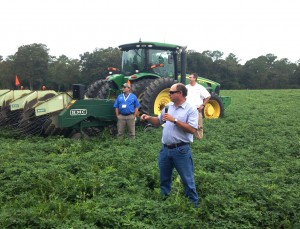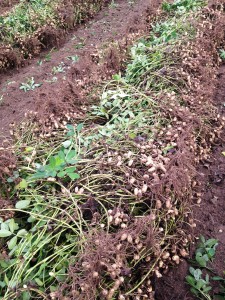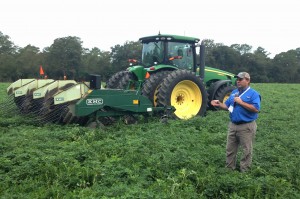Wednesday morning kicked off with the first stop of the 2015 Georgia Peanut Tour at Bell Farms in Climax, Georgia. Andy Bell and his brother Buster have been farming together for more than 30 years. Bell and his brother raise cattle and grow approximately 900 acres of peanuts, 1,100-1,200 acres of cotton and 200 acres of corn and silage in Decatur County. Of their peanuts, approximately 800 acres are GA-06G, 60 acres are Tiff Guard and 45 acres are Florida 107, a high oleic variety.
During the morning visit, Bell showed attendees a field of GA-06Gs and discussed how he manages the field. “These particular peanuts have been sprayed three times with Provost and one time with Headline,” Bell said. “They are about 125 days old; not quite ready to dig.” The maturity range for GA-06G is approximately 135-145 days after planting, depending on the weather. He also mentioned how there is no hand-weeding in the field. Even though Bell and his family spray their field throughout the growing season, a lot of their herbicides are put into place at the time of planting.
Bell went on to discuss his family’s use of GPS technology on their equipment. “All of our crops are managed with GPS and we really feel like that saves us money on gathering, planting and spraying; it just makes everything work a lot better when you have a straight row…It’s a really good system and it works well.” The GPS technology steers the tractor down to within a couple of inches accuracy. This type of tool can cost growers approximately $30,000, depending on the model. Bell and his family run two, six-row diggers. During harvest, they normally start early in the morning with digging and pick all afternoon. They have family members hauling peanuts and drying them, as well.
According to Bell, the field size varies across the county. “Typically, on this side of the county, the field size is smaller. This particular field is a 30 acre, irrigated field. Our largest irrigated peanut field is about 115 acres. The land on this side of the river just doesn’t lay well enough to have larger fields.”
Dr. Bob Kemerait, UGA plant pathologist, pointed out how well Bell Farms’ looked and commended him for his practices. He discussed how a field that looks as good as Bell Farms’ is not easy to achieve; it is difficult. Education and innovation of Georgia’s peanut growers, as well as cooperation with UGA Extension is also important in helping Georgia farmers grow the highest quality peanuts.
Dr. Scott Monfort, UGA peanut agronomist, pointed out how expensive it is for Georgia peanut farmers. “We’re getting to bigger and bigger equipment, more technology; and that’s more expense. This is probably a couple hundred thousand dollars’ worth of equipment sitting right here, and that’s not to mention he’s probably got several of these that he runs on 800 acres.” He commented on how the industry is appreciative of Georgia growers and the long hours and money they invest to grow a quality crop.
When asked questions from tour attendees, Bell said he and his brother do not typically plant cover crops; however, on dry years, they will bale peanut hay and feed it to their cattle. When selecting varieties to plant, nematodes are the key influencer. “If it’s dryland, we plant Tiff Guard, which has resistance to nematodes.” For a variety like GA-06G, Bell says approximately four gallons of Telone, used for nematode control, is put out in the row and peanuts are planted right behind it. The selection of Florida 107 for planting was market driven because of the high oleic trait. For those who are unfamiliar, high oleic is related to the ratio of linoleic acid in the peanut. It allows the peanut to have a longer shelf-life, making it more desirable to food manufacturers. When asked about rotation, Bell mentioned cotton and corn as rotational crops. “Typically our rotation is two years of cotton and/or corn, or corn silage and one year of peanuts. Sometimes it can be more or less depending on the situation.”
To conclude the tour stop, Dr. Monfort, Dr. Kemerait and Bell discussed the expected yield of the presented field. “They [peanuts] could be between two and three tons per acre, it just depends on how mature they are,” Monfort said. Kemerait added, “If he makes three tons out here and right now the price is about $400/ton, he makes $1,200.” When asked about how much he spends per acre, Bell replied “roughly $900-$1,000 an acre…it’s our highest dollar crop and irrigated peanuts would be hard to grow for less than $900 per acre…if we make two tons out here, we will break even.” Kemerait pointed out how it is not easy or always profitable to be a peanut farmer.
According to Brian Hayes, UGA extension agent, Decatur County has a farm gate value of $200+ million annually and farms between 25,000-28,000 acres of peanuts historically; however, in 2015, there have been approximately 35,000 acres of peanuts planted throughout the county.
To view a digging demonstration at Bell Farms, view the video below.
View the 2015 Georgia Peanut Tour Photo Album



